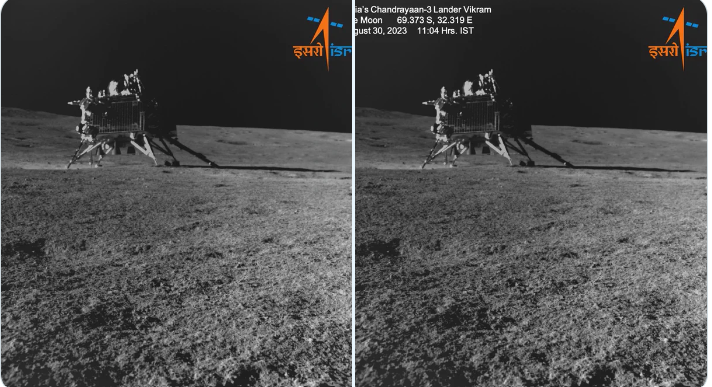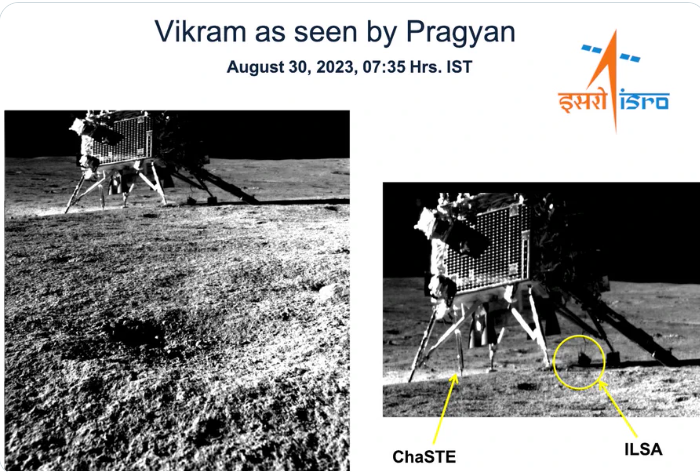Newsnomics AJAY ANGELINA reporter |
India's Chandrayaan-3 co-traveler Pragyan clicks photos of Vikram (Lander) in a Space around 11 am IST from about 15 m near the South pole of the moon.
Beyond Borders, Across Moonscapes: India's Majesty knows no bounds! said the Indian space Research Organization (ISRO) today by sharing the images on X broadcast by the space rover.

Earlier, Pragyaan (Rover) snaps photo of Vikram (Lander) for the first time on presenting the two continue their ground-breaking exploration on the lunar surface near the lunar South pole.
The ISRO allowed to leave two black and white images of Vikram (Lander)) on Wednesday, August. 30 in X
formerly Twitter, showing the Chandrayaan-3 mission's lander bolster up on its legs against the dust-covered
lunar surface.
Smile, please ! Pragyan Rover clicked an image of Vikram Lander this morning," ISRO said.

The ISRO post on X also shows that the image was taken on Wednesday (Aug. 30) at 7:35 a.m. Indian Standard Time (10:30 p.m. EDT on Tuesday, Aug. 29, or 0130 GMT on Wednesday).
"The 'image of the mission' was taken by the Navigation Camera onboard the Rover (NavCam) developed by the Laboratory for Electro-Optics Systems (LEOS) mentioned by the ISRO.
One of the images is broadcasting two of Vikram's science sensors ChaSTE- the Chandra's Surface Thermophysical Experiment and ILSA- the Instrument for Lunar Seismic Activity positioned on the Lunar surface.
Chandrayaan-3 space lander contains 4 payloads -- RAMBHA to measure the near surface plasma density, ChaSTE to measure the thermal properties of the soil, ILSA to measure the seismicity around the landing site and LRA to understand the dynamics of the lunar system.
The mission's ChaSTE, earlier this week took temperature measurements, the first such measurements taken near the southern polar by its 4 inches (10 centimeters) deep drilled probe directly on the lunar surface rather than from the orbit revealed that just 3 inches (8 cm) below the surface, the soil is a freezing 14 degrees Fahrenheit (minus 10 degrees Celsius), while the surface is boiling at over 140 degrees F (60 degrees C).
According to NASA, the previously made measurements by spacecraft orbiting the moon showed temperatures can reach a hellish 260 degrees Fahrenheit (127 degrees Celsius) during the day and plummet to frigid minus 280 degrees Fahrenheit (-173 degrees Celsius) at night.
India’s Chandrayaan-3 is now half-way of its ground-breaking mission on the moon and will not be able to survive in the upcoming two-week lunar night because the solar-powered vehicles’ batteries are not powerful enough midst the temperatures plummet and darkness that covers the lunar surface.










